第四章 Django 模板系统
第一章 Django 基本使用
第二章 Django URL路由系统
第三章 Django 视图系统
第四章 Django 模板系统
第五章 Django 数据模型系统(基本使用)
第六章 Django 数据模型系统(多表操作)
第七章 Django 用户认证与会话技术
第八章 Django CSRF防护
文章目录
模板系统
模板是什么
Django模板系统:用于自动渲染一个文本文件,一般用于HTML页面。模板引擎渲染的最终HTML内容返回给客户端浏览器
模板文件有两部分组成:
静态部分,例如html\css\js
动态部分,django模板语言,类似jinja语法
变量
变量定义:再函数视图render中的context传入,类似于字典对象
变量再模板中引用,格式:{{ key }}
路由
# devops/urls.py
from django.urls import path
from myapp import views
urlpatterns = [
re_path('templates/$',views.templates)
]
视图
# myapp/views.py
from django.shortcuts import render,HttpResponse,redirect
import os
from django.http import StreamingHttpResponse,FileResponse
from django.http import JsonResponse
def templates(request):
user = {'user':'wang','LA':{ 'age': '22','sex':'go'}}
return render(request,'templates.html',{ 'user' : user })
网页
# templates/templates.html
<!DOCTYPE html>
<html lang="en">
<head>
<meta charset="UTF-8">
<title>文件列表</title>
</head>
<body>
<h1>模板文件</h1>
name: {{ user.user }}<br>
age: {{ user.LA.age }}<br>
sex: {{ user.LA.sex }}
</body>
</html>
验证
http://49.232.221.200:8888/templates/
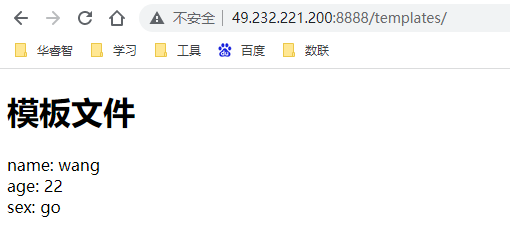
设置全局变量
示例:设置全局变量
1.再项目中创建contexts.py文件
def user(request):
username = request.session.get('username')
return {'username':username}
2.在settings.py文件中添加你的上下文处理器
contexts文件创建
# devops/contexts.py
def users(request):
username = 'wang'
return {'username':username}
配置文件
# devops/settings.py
TEMPLATES = [
{
'BACKEND': 'django.template.backends.django.DjangoTemplates',
'DIRS': [os.path.join(BASE_DIR, 'templates')],
'APP_DIRS': True,
'OPTIONS': {
'context_processors': [
'django.template.context_processors.debug',
'django.template.context_processors.request',
'django.contrib.auth.context_processors.auth',
'django.contrib.messages.context_processors.messages',
'devops.contexts.users', ## 增加这一行
],
},
},
]
网页
# templates/templates.html
<!DOCTYPE html>
<html lang="en">
<head>
<meta charset="UTF-8">
<title>文件列表</title>
</head>
<body>
<h1>模板文件</h1>
name: {{ user.user }}<br>
age: {{ user.LA.age }}<br>
sex: {{ user.LA.sex }}
<h3>姓名: {{ username }}</h3>
</body>
</html>
# templates/upload_list.html
<!DOCTYPE html>
<html lang="en">
<head>
<meta charset="UTF-8">
<title>文件列表</title>
</head>
<body>
{% for i in file_list %}
<a href="{% url 'download' i %}">{{ i }}</a><br>
{% endfor %}
<h3>姓名: {{ username }}</h3>
</body>
</html>
验证
两个访问路径都可以看到 姓名:wang
http://49.232.221.200:8888/templates/

http://49.232.221.200:8888/upload_list/
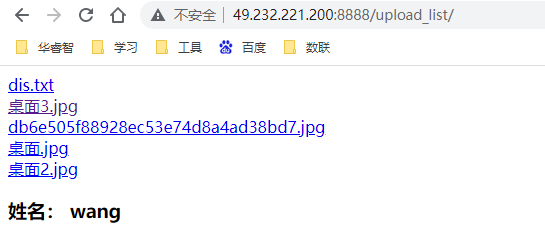
流程控制:条件和循环
标签:条件判断
if条件判断:判定给定的条件是否满足(True或False),根据判断的结果决定执行的语句
语法:
{% if <表达式> %}
<内容块>
{% elif <表达式> %}
<内容块>
{% else %}
<内容块>
{% endif %}
视图
# myapp/views.py
from django.shortcuts import render,HttpResponse,redirect
import os
from django.http import StreamingHttpResponse,FileResponse
from django.http import JsonResponse
def templates(request):
user = {'A':{ 'user':'wang', 'age': '22','sex':'go'},
'B':{ 'user':'xing', 'age': '23','sex':'baby'},
'C':{ 'user':'zhang','age': '24','sex':'tian'},
}
return render(request,'templates.html',{ 'user' : user })
网页
# templates/templates.html
<!DOCTYPE html>
<html lang="en">
<head>
<meta charset="UTF-8">
<title>文件列表</title>
</head>
<body>
<h1>模板文件</h1>
{% if user.B.age == '43' %}
name: {{ user.B.user }}<br>
age: {{ user.B.age }}<br>
sex: {{ user.B.sex }}<br>
{% else %}
{{ user.B.user }} 不等于 23
{% endif %}<br>
<h3>姓名: {{ username }}</h3>
</body>
</html>
验证
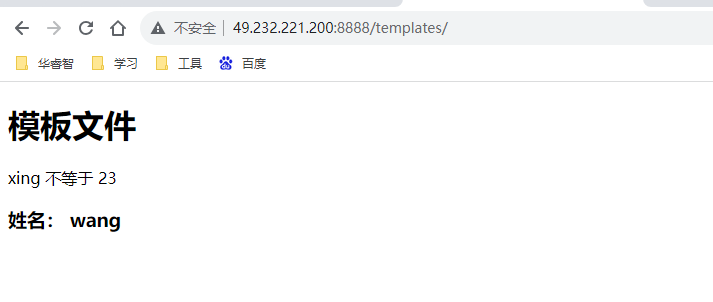
网页
# templates/templates.html
<!DOCTYPE html>
<html lang="en">
<head>
<meta charset="UTF-8">
<title>文件列表</title>
</head>
<body>
<h1>模板文件</h1>
{% if user.B.age == '23' %}
name: {{ user.B.user }}<br>
age: {{ user.B.age }}<br>
sex: {{ user.B.sex }}<br>
{% else %}
{{ user.B.user }} 不等于 23
{% endif %}<br>
<h3>姓名: {{ username }}</h3>
</body>
</html>
验证
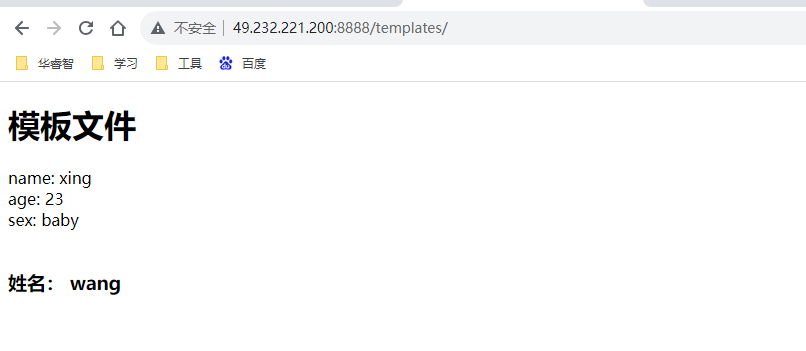
标签:循环
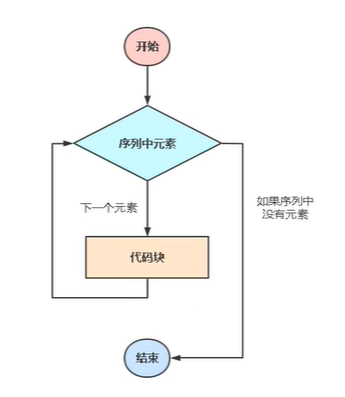
for循环:一般用于遍历数据类型的元素进行处理,例如列表。
语法:
{% for <变量> in <序列> %}
<内容块>
{% endfor %}
视图
# myapp/views.py
from django.shortcuts import render,HttpResponse,redirect
import os
from django.http import StreamingHttpResponse,FileResponse
from django.http import JsonResponse
def templates(request):
user = {'A':{ 'user':'wang', 'age': '22','sex':'go'},
'B':{ 'user':'xing', 'age': '23','sex':'baby'},
'C':{ 'user':'zhang','age': '24','sex':'tian'},
}
return render(request,'templates.html',{ 'user' : user })
网页
# templates/templates.html
<!DOCTYPE html>
<html lang="en">
<head>
<meta charset="UTF-8">
<title>文件列表</title>
</head>
<body>
<table border="1">
<thead>
<tr>
<th>用户名</th>
<th>年龄</th>
<th>性别</th>
</tr>
</thead>
<thead>
<br><br>
{% for k, v in user.items %}
<tr>
<td>{{ v.user }}</td>
<td>{{ v.age }}</td>
<td>{{ v.sex }}</td>
</tr>
{% endfor %}
</thead>
</table>
</body>
</html>
验证
http://49.232.221.200:8888/templates/
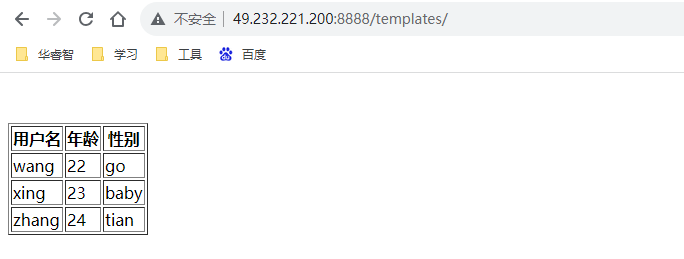
标签:forloop变量
在Django模板中,forloop是一个特殊的变量,它包含了当前循环的相关信息。这个变量是在{% for %}标签中生成的,用于获取当前循环进展的信息
变量描述forloop.counter循环计数器,当前循环的索引从1开始forloop.counter0循环计数器,当前循环的索引从0开始forloop.revcounter当前
| 变量 | 描述 |
|---|---|
| forloop.counter | 循环计数器,当前循环的索引从1开始 |
| forloop.counter0 | 循环计数器,当前循环的索引从0开始 |
| forloop.revcounter | 当前循环倒数计数,最后一次循环为1,反向计数 |
| forloop.revcounter0 | 当前循环倒数计数,最后一次循环为0,反向计数 |
| forloop.first | 当前循环为第一个循环时,该变量为True |
| forloop.last | 当前循环为最后一个循环时,该变量为True |
| forloop.parentloop | 再嵌套循环中,指向当前循环的上级循环 |
视图
# myapp/views.py
from django.shortcuts import render,HttpResponse,redirect
import os
from django.http import StreamingHttpResponse,FileResponse
from django.http import JsonResponse
def templates(request):
user = {'A':{ 'user':'wang', 'age': '22','sex':'go'},
'B':{ 'user':'xing', 'age': '23','sex':'baby'},
'C':{ 'user':'zhang','age': '24','sex':'tian'},
}
return render(request,'templates.html',{ 'user' : user })
网页
# templates/templates.html
<!DOCTYPE html>
<html lang="en">
<head>
<meta charset="UTF-8">
<title>文件列表</title>
</head>
<body>
<table border="1">
<thead>
<tr>
<th>编号</th>
<th>用户名</th>
<th>年龄</th>
<th>性别</th>
</tr>
</thead>
<thead>
<br><br>
{% for k, v in user.items %}
<tr>
{% if forloop.first %}
当前第一个循环
{% else %}
不是第一个循环
{% endif %}
{{ forloop.first}}
<td>{{ forloop.counter }}</td>
<td>{{ v.user }}</td>
<td>{{ v.age }}</td>
<td>{{ v.sex }}</td>
</tr>
{% endfor %}
</thead>
</table>
</body>
</html>
验证
http://49.232.221.200:8888/templates/
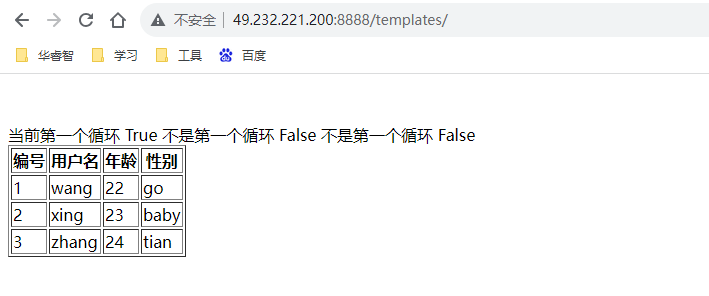
操作符
| 变量 | 描述 |
|---|---|
| 比较操作符 | == 等于 != 不等于 >大于 < 小于 >= 大于等于 <= 小于等于 |
| 逻辑操作符 | and 与or 或 |
| 成员操作符 | not 逻辑否定 in 包含在内 |
过滤器:在变量被显示前修改值的一种方法。
语法:{{ value | 过滤器:参数 }}
| 过滤器 | 说明 | 示例 |
|---|---|---|
| add | 将两个值转换为整数相加 | {{ 11 | add:“6” }} 结果 17 |
| cut | 切除字符。从给定字符串中删除arg的所有值。 | {{ “hello world” | cut:“w” }} 结果 hello orld |
| default | 如果值的计算结果为 False,则使用给定的默认值。否则,使用该值。 | {{ “” | default:“hello world” }} 结果 hello world |
| first | 返回第一个元素 | { “hello world” | first }} 结果 h |
| last | 返回最后一个元素 | { “hello world” | last }} 结果 d |
| join | 使用字符串连接列表,如Python的 str.join(list) | { abc | join:“,” }} 结果 1,2,3 # abc = [1,2,3] |
| length | 返回值的长度。这适用于字符串和列表 | {{ “hello world” | length }} 结果 11 |
| lower | 将字 符串转换为小写 | { “AAA” | lower }} 结果 aaa |
| upper | 将字符串转换为大写 | { “aaa” | upper }} 结果 AAA |
| slice | 切片, 类似于Python中的切片操作。 | { “hello world” | slice:“2:” }} 结果 llo world |
| title | 所有单词首字母大写 | { “aaa” | title }} 结果 Aaa |
| truncatechars | 如果长度大于指定的字符数,则截断字符串。截断的字符串将以可翻译的省略号序列(“…”)结束 | {{ “hello world” | truncatechars:2 }} 结果 h… |
| filesizeformat | 将该值格式化为“人类可读”文件大小(即 ‘13 KB‘,‘4.1 MB‘,‘102 bytes‘ 等)。 | {{ 10000 | filesizeformat }} 结果 9.8 KB |
| floatformat | 当不带参数时,将一个浮点数舍入到小数点后一位,但前提是要显示一个小数部分。 | {{ 1.33333333 | floatformat }} 结果 1.3floatformat:2 指定保留的小数位数 |
举例:首字母大写
视图
# myapp/views.py
from django.shortcuts import render,HttpResponse,redirect
import os
from django.http import StreamingHttpResponse,FileResponse
from django.http import JsonResponse
def templates(request):
user = {'A':{ 'user':'wang', 'age': '22','sex':'go'},
'B':{ 'user':'xing', 'age': '23','sex':'baby'},
'C':{ 'user':'zhang','age': '24','sex':'tian'},
}
return render(request,'templates.html',{ 'user' : user })
网页
# templates/templates.html
<!DOCTYPE html>
<html lang="en">
<head>
<meta charset="UTF-8">
<title>文件列表</title>
</head>
<body>
<table border="1">
<thead>
<tr>
<th>编号</th>
<th>用户名</th>
<th>年龄</th>
<th>性别</th>
</tr>
</thead>
<thead>
<br><br>
{% for k, v in user.items %}
<tr>
{% if forloop.first %}
当前第一个循环
{% else %}
不是第一个循环
{% endif %}
{{ forloop.first}}
<td>{{ forloop.counter }}</td>
<td>{{ v.user | upper }}</td>
<td>{{ v.age }}</td>
<td>{{ v.sex }}</td>
</tr>
{% endfor %}
</thead>
</table>
</body>
</html>
验证
http://49.232.221.200:8888/templates/
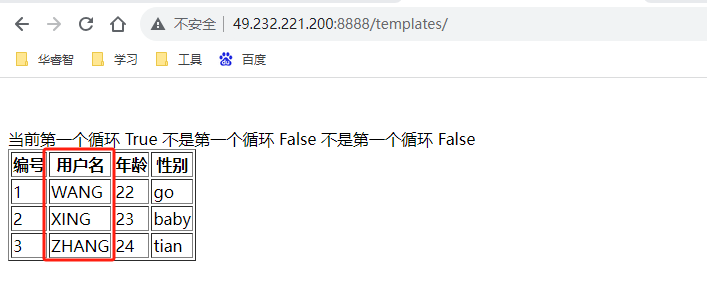
自定义过滤器
1、在app下创建templatetags目录
2、自定义过滤器函数
from django.template import Library
register = Library() # 注册过滤器对象
@register.filter # 通过装饰注册自定义过滤器
def func(n):
return n / 2
3、在模板中使用
{% load filters %}
{{ 123 | func }}
# devops/settings.py
INSTALLED_APPS = [
'django.contrib.admin',
'django.contrib.auth',
'django.contrib.contenttypes',
'django.contrib.sessions',
'django.contrib.messages',
'django.contrib.staticfiles',
"myapp", # 增加这一行
]
自定义
# myapp/templatetags/custom.py
from django.template import Library
register = Library() # 注册过滤器对象
@register.filter # 通过装饰注册自定义过滤器
def func(n):
return n / 2
网页
# templates/templates.html
<!DOCTYPE html>
<html lang="en">
<head>
<meta charset="UTF-8">
<title>文件列表</title>
{% load custom %} # 引用自定义模块
</head>
<body>
<br>
{{ 123 | func }}<br>
{{ 666 | func }}
</br>
</body>
</html>
验证
http://49.232.221.200:8888/templates/

注释
模板中注释语法:
{# 注释内容 #}
模板继承
模板继承主要是为了提高代码重用,减轻开发人员的工作量。
典型应用:网站的头部、尾部信息。
1、定义一个基础模板,也称为母板,这个页面存放整个网站共用的内容
templates/base.html
2、在子模板继承这个母版
{% extends ‘base.html’ %}
3、在基础模板预留子模板差异化内容
{% block 名称 %} 预留区域 {% endblock %}
4、在子模板里同样语法引用并填充预留区域内容
路由
# devops/urls.py
from django.urls import path,re_path
from myapp import views
urlpatterns = [
re_path('about/$',views.about),
re_path('news/$',views.news)
]
视图
# myapp/views.py
from django.shortcuts import render,HttpResponse,redirect
def about(request):
return render(request, 'about.html')
def news(request):
return render(request, 'news.html')
网页
# templates/base.html
<!DOCTYPE html>
<html lang="en">
<head>
<meta charset="UTF-8">
<title>{% block title %}{% endblock %}</title>
{% block style %} {% endblock %}
</head>
<body>
<nav class="nav">
<a href="#">仪表盘</a>
<a href="#">发布管理</a>
<a href="#">容器管理</a>
</nav>
<div class="context">
{% block context %} 预留区域 {% endblock %}
</div>
<footer class="footer">
底部
</footer>
</body>
</html>
# templates/about.html
{% extends 'base.html' %}
{% block title %}关于我们{% endblock %}
{% load static %}
{% block style %}
{% endblock %}
{% block context %}
这是关于我们
{% endblock %}
# templates/news.html
{% extends 'base.html' %}
{% block title %}新闻{% endblock %}
{% block context %}
这是新闻页面
{% endblock %}
验证
http://49.232.221.200:8888/about/
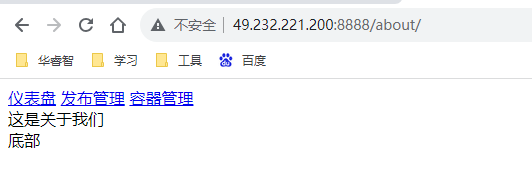
http://49.232.221.200:8888/news/

模板导入
模板导入:导入一个模板(一般是某个网页功能)到当前模板
接着模板继承的写
路由、视图都不变
网页
# templates/htllo.html
<div style="background-color: red;width: 100px;height: 100px">
这是一个功能模板
</div>
# templates/about.html
{% extends 'base.html' %}
{% block title %}关于我们{% endblock %}
{% load static %}
{% block style %}
{% endblock %}
{% block context %}
这是关于我们
{% include 'hello.html' %}
{% endblock %}
# templates/news.html
{% extends 'base.html' %}
{% block title %}新闻{% endblock %}
{% block context %}
这是新闻页面
{% include 'hello.html' %}
{% endblock %}
验证
http://49.232.221.200:8888/about/

http://49.232.221.200:8888/news/
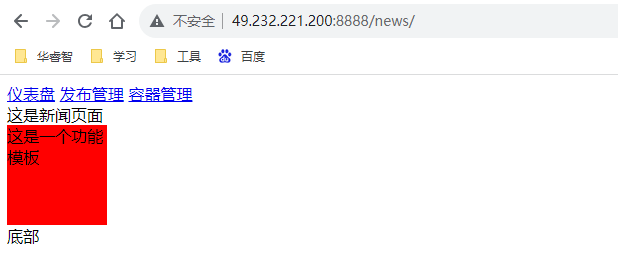
引入静态文件
? STATICFILES_DIRS:告诉Django哪个目录是“静态文件的文件夹”
? STATIC_ROOT:指出浏览器访问静态文件“根路径”
1、在settings.py配置
BASE_DIR = os.path.dirname(os.path.dirname(os.path.abspath(file)))
STATICFILES_DIRS = (
os.path.join(BASE_DIR, ‘static’),
)
STATIC_URL = ‘/static/’
2、在模板文件引用静态文件
<link rel=“stylesheet” href=“/static/main.css”>
或者
<link rel=“stylesheet” href="{% static ‘main.css’ %}
# devops/settings.py
# 最下边新增
# BASE_DIR = os.path.dirname(os.path.dirname(os.path.abspath(file))) 这一个里边默认就用,可以确认下,没有的话添加
STATICFILES_DIRS = (
os.path.join(BASE_DIR, 'static'),
)
创建css
# myapp/static/main.css
.test {
color: red;
}
网页
# templates/about.html
{% extends 'base.html' %}
{% block title %}关于我们{% endblock %}
{% load static %}
{% block style %}
<link rel="stylesheet" href="{% static 'main.css' %}">
{% endblock %}
{% block context %}
这是关于我们
{% include 'hello.html' %}
<div class="test">
这是引用的外部css
</div>
{% endblock %}
验证
http://49.232.221.200:8888/about/

本文来自互联网用户投稿,该文观点仅代表作者本人,不代表本站立场。本站仅提供信息存储空间服务,不拥有所有权,不承担相关法律责任。 如若内容造成侵权/违法违规/事实不符,请联系我的编程经验分享网邮箱:chenni525@qq.com进行投诉反馈,一经查实,立即删除!
- Python教程
- 深入理解 MySQL 中的 HAVING 关键字和聚合函数
- Qt之QChar编码(1)
- MyBatis入门基础篇
- 用Python脚本实现FFmpeg批量转换
- Java项目开发:基于Java+spingboot+vue汽车租赁系统的设计与实现
- Linux的发展历程:从诞生到全球应用
- 《亚太教育》期刊投稿方式
- 一文带你认识JVM
- Python 发微信:实现自动化沟通的利器
- Vivado 内存溢出
- Go并发:使用sync.Pool来性能优化
- SpringBoot—数据访问
- go语言基础 -- defer及其用法
- e2studio开发三轴加速度计LIS2DW12(1)----轮询获取加速度数据